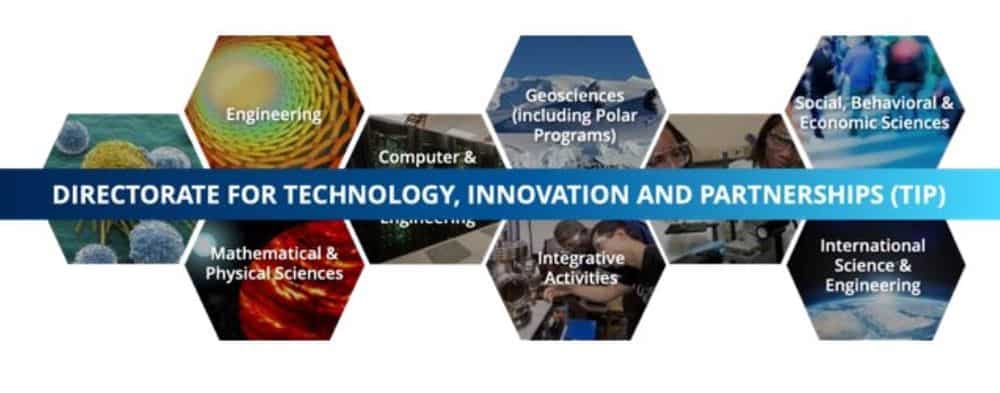
[Image above] Credit: National Science Foundation TIP
When President Joe Biden signed the Chips and Science Act of 2022 into law this August, many news sites focused on the provisions relating to the semiconductor industry. However, this act also established a concrete framework for the National Science Foundation’s new Directorate for Technology, Innovation, and Partnerships (TIP).
The TIP directorate is the first new NSF directorate in more than 30 years. The genesis for this directorate comes from a push by key U.S. senators to increase federal support for applied research.
NSF officially established the TIP directorate in March 2022, but the mission and scope of the directorate remained unclear due to differing visions in the House and Senate. The Chips and Science Act of 2022 consolidates these visions by giving the directorate a three-fold mission: supporting use-inspired and translational research, accelerating development of key technologies, and expanding the domestic STEM workforce.
Recently, FYI, the editorially independent science policy news service of the American Institute of Physics, published a thorough overview of the priorities, programs, and activities of the TIP directorate. Below are some key points from the overview.
TIP directorate finds compromise between strategic technologies and fundamental research
Though lawmakers generally agreed that NSF should take a larger role in supporting use-inspired research, the House and Senate diverged over how to implement this idea. Senators advocated for research tied to strategic technologies, whereas House representatives sought to protect NSF’s traditional focus on fundamental research while addressing broad societal and economic needs.
The final legislation balances these two approaches by requiring the directorate to address no more than 10 “key technology focus areas” and no more than five “societal, national, and geostrategic challenges.” The NSF director must annually review the technology and challenge area lists and update them as necessary.
Key technology focus areas
- Artificial intelligence, machine learning, autonomy, and related advances
- High performance computing, semiconductors, and advanced computer hardware and software
- Quantum information science and technology
- Robotics, automation, and advanced manufacturing
- Natural and anthropogenic disaster prevention or mitigation
- Advanced communications technology and immersive technology
- Biotechnology, medical technology, genomics, and synthetic biology
- Data storage, data management, distributed ledger technologies, and cybersecurity, including biometrics
- Advanced energy and industrial efficiency technologies, including but not limited to for the purposes of electric generation
- Advanced materials science, including composites, 2D materials, other next-generation materials, and related manufacturing technologies
Societal, national, and geostrategic challenges
- National security
- Manufacturing and industrial productivity
- Workforce development and skills gaps
- Climate change and environmental sustainability
- Inequitable access to education, opportunity, or other services
“Regional Innovation Engines” to be first flagship initiative of TIP directorate
The TIP directorate assumed responsibility for several established NSF programs, including the Innovation Corps (I-Corps) entrepreneurial education program and the “Convergence Accelerator” for multidisciplinary research.
It is also home to the new Regional Innovation Engines program NSF launched in May 2022.
The Regional Innovation Engines program is part of a broader push to expand the geographic distribution of U.S. innovation. It will fund multisector partnerships (“Engines”) in places that are not already leading hubs of technology development.
Each “Engine,” which can be led by universities, nonprofit organizations, or for-profit entities, will conduct use-inspired R&D, translate research outputs into practical applications, and promote regional workforce development. Each Engine proposal must tackle a major societal and/or economic challenge relevant to its region.
Funding opportunities for NSF Engines are divided into Type-1 and Type-2 awards, depending on how mature the Engine’s surrounding innovation ecosystem is determined to be.
- Type-1 awards, which can be up to $1 million for up to two years, enable prospective engines to lay the groundwork for development of a successful regional innovation ecosystem.
- Type-2 awards, which can be up to $160 million for up to 10 years, are meant to drive translational research and technological development using the partnerships and connectivity infrastructure among participating stakeholders in service of the identified topic.

The Chips and Science Act of 2022 recommends that Congress appropriate a combined $6.5 billion over five years for the Regional Innovation Engines program as well as a new Translation Accelerators program, without specifying how the funding should be split.
The Translation Accelerators are partnerships that comprise two or more types of entities to further research, development, and commercialization of innovation in the key technology focus areas, with nonfederal partners pitching in at least 25% of the costs.
The act does not specify a target number of Accelerators, but it encourages NSF to seek a balance between the number of Engines and Accelerators.
Additional programs and funding opportunities
In addition to the Regional Innovation Engines and Translation Accelerators, the TIP directorate will support a new early-career fellowships program and a new partnership program with NSF’s STEM Education Directorate that offers experiential learning opportunities for individuals from diverse professional and educational backgrounds.
The TIP directorate will also coordinate a new program called “Pathways to Enable Open-Source Ecosystems” (POSE), which aims to harness the power of open-source development for the creation of new technology solutions. In September 2022, NSF announced the first cohort of POSE awards, consisting of 25 grants worth a combined total of $8 million.
In a recent webinar, TIP directorate assistant director Erwin Gianchandani provides more details on the TIP directorate’s mission, programs, and status. (Slides from the presentation are available here.)

Credit: National Science Foundation TIP, YouTube
NSF will likely roll out additional TIP use-inspired programs and initiatives once Congress finalizes its appropriations for fiscal year 2023. Until then, you can receive updates about the TIP directorate by signing up for the TIP newsletter at this link.
Author
Lisa McDonald
CTT Categories
- Education
- Market Insights


